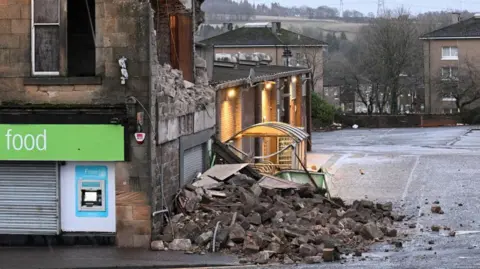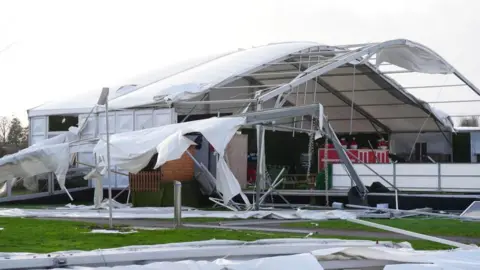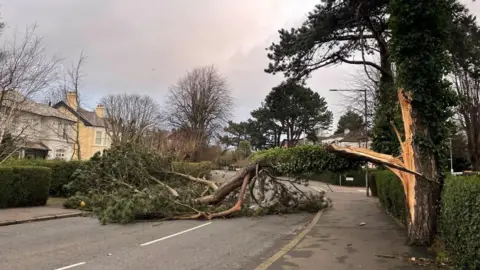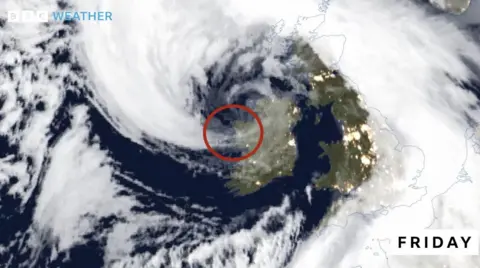One dead and nearly a million without power in Storm Éowyn
One person has died in Ireland and hundreds of thousands of homes are without power in the UK as Storm Éowyn brought record-breaking wind gusts.
The man died when a tree fell on his car in County Donegal, Gardaí (Irish police) said.
Ireland saw its strongest gusts ever recorded, leading to 725,000 properties without power and around 138,000 people without water.
Across the UK, millions of people were urged to stay at home as gusts of 100mph (160km/h) were recorded on Friday.
One in five flights were cancelled and all trains halted in Scotland. Every school in Northern Ireland was closed as the storm damaged buildings and tore down trees.
An amber wind warning remains in place for parts of Scotland.
The strongest winds had passed by Friday evening, but the storm was still expected to bring gusts of more than 80mph (128km/h) across the coast and hills of Scotland and Northern Ireland.
Two red warnings were in force earlier on Friday in Northern Ireland and parts of Scotland.
Red is the most serious weather warning the Met Office can issue, meaning dangerous weather is expected and people are urged to take action to keep safe.
There are also yellow warnings for wind, rain, snow and ice across the UK over the next few days.
Northern Ireland was in "the eye of the storm" with a real threat to life and property, First Minister Michelle O'Neill had said.
The storm brought the strongest wind gusts in 27 years there.
The number of properties without power fell slightly to 250,000, NIE Networks said, but it could take up to 10 days for everywhere to be reconnected.
Scotland's First Minister John Swinney called the storm an "exceptional weather event" and said a "high level of vigilance" is still required.
Around 117,000 homes and businesses are without power in Scotland - and roughly 1,200 more in Wales, according to SP Energy Networks.
Thousands of homes were also without power in England across Northumberland, County Durham, Tyne and Wear and Cumbria.
There was severe disruption at airports, with some 1,124 flights cancelled, affecting around 150,000 passengers, according to aviation analytics firm Cirium said.
Dublin, Edinburgh, Heathrow and Glasgow were the worst affected airports, it added.
A Ryanair flight that left Stansted Airport in Essex for Edinburgh reached the skies above the Scottish capital - but was unable to land and flew back to Stansted.
 Reuters
ReutersBus and train services were suspended in Northern Ireland, while supermarket chain Tesco said all its stores are closed and home deliveries cancelled.
Ferry operators also had to cancel numerous crossings.
Glasgow and Edinburgh closed all of their schools. Around 30 schools were shut across Northumberland, seven in Cumberland, and 50 in Wales.
The UK's top wind gust speed of 100mph was recorded at Drumalbin in South Lanarkshire in Scotland.
In Ireland, a gust of 114mph (183km/h) was recorded at Mace Head in County Galway. This makes it the strongest recorded gust of wind in the country.
Ireland's weather service Met Éireann had issued severe red weather warnings - with BBC Weather saying it could be Ireland's storm of the century.
Around 138,000 people across the country had no water on Friday evening, with the supplies of another 750,000 at risk, utility company Uisce Eireann said.
The Electricity Supply Board said there was "unprecedented, widespread and extensive damage to electricity infrastructure" and it will take a "significant number of days" to restore power.
Connacht GAA's Air Dome - an indoor playing facility in County Mayo in Ireland - was destroyed as winds ripped through the £2.6m facility.
 PA Media
PA Media'Extreme weather'
Jake Kelly, from Network Rail, said no trains were running in the whole of Scotland, as well as north of Preston on the west coast mainline in England and north of Newcastle on the east coast mainline, on Friday.
"We expect a large amount of debris to be flying around and potentially trees to fall over," he told BBC Breakfast.
"It's always a very, very difficult decision to close the railway but in the face of this very extreme weather, ultimately we had no choice."
ScotRail said customers should not expect any trains to run before 12:00 on Saturday.
Train operator Northern said many of its routes were closed.
 PA Media
PA MediaNine UK warnings are in place:
- Amber warning for wind across parts of Scotland from 13:00 on Friday to 06:00 on Saturday
- Yellow warning for wind across most of the country from midnight on Friday until 23:59 on Sunday
- Yellow warning for snow in parts of Scotland from 06:00 until 23:59 on Friday
- Yellow warning for snow and ice for Northern Ireland from 19:00 on Friday until 10:00 on Saturday
- Yellow warning for wind in parts of Scotland from midnight until 15:00 on Saturday
- Yellow warning for snow and ice in parts of Scotland from midnight until 11:00 on Saturday
- Yellow warning for ice for Midlands, east and south-east England and Wales from 03:00 until 10:00 on Saturday
- Yellow warning for rain for Wales and most of England from 08:00 on Sunday until 06:00 on Monday
- Yellow warning for wind for south-east and west England, Wales, Northern Ireland and south-west Scotland, from 08:00 until 15:00 on Sunday
Storm Éowyn - pronounced AY-oh-win - has been caused by powerful jet stream winds pushing low pressure towards the UK and Ireland over the Atlantic Ocean - after a recent cold spell over North America.
'Stingjet'
While crossing the Atlantic, Storm Éowyn underwent a process known as "explosive cyclogenesis" – sometimes called a "weather bomb".
This term is used to describe an area of low pressure that deepens by at least 24 millibars in 24 hours. Storm Éowyn deepened by 50 millibars in 24 hours.
Explosive cyclogenesis is generally a sign of a storm that will bring extremely strong winds.
It is also possible the west coast of Ireland has been hit by a "stingjet".
This can occur where strong winds higher in the atmosphere are forced to the ground, resulting in wind speeds in excess of 100mph.
A stingjet can normally be detected on a satellite image as the hook – or sting in the tail – to the southern side of the storm.
They normally can last for three or four hours, bringing the most damaging winds.

